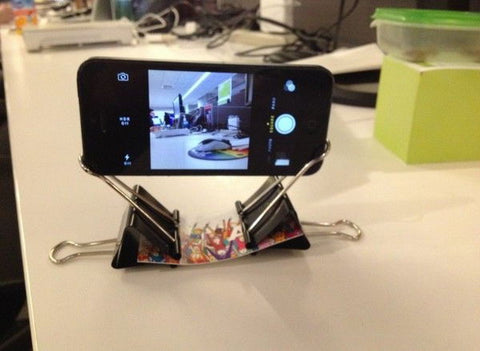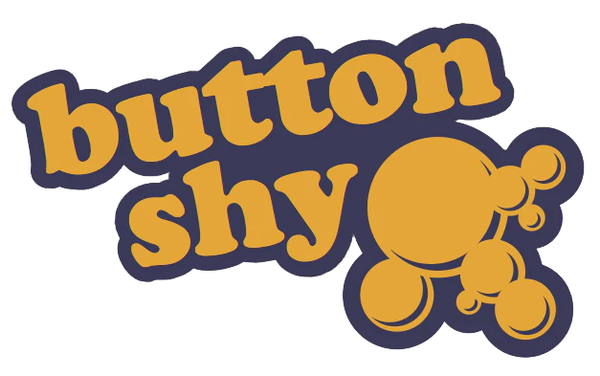18 Card Challenge - Lights, Camera, Pitch!
Share
Remember the disclaimer from last time? Still applies. Mike's opinions are worth listening to, but are not official Button Shy policy. - Jason

I've Got the Talking Stick Again!
Welcome back to our look behind the curtain of the 18 Card Challenge. Today I want to address the second most common question topic: the pitch video. Many of you were looking for a "how to", while others asked about ways to stand out and make it through that first selection phase.

This genius homemade phone stand (from this list) is the perfect photo to introduce this segment, because everyone can make a video. For many people, the pitch video is the barrier to entry, but it shouldn't be!
First and foremost, we do not care about the video quality. As long as the audio is understandable and we can see the gameplay, we're satisfied! Your cellphone is likely the best camera you have, so strap it to something and start shooting! Much like playtesting, if you shoot a few short 30 second clips of yourself talking and shuffling cards, you can get an idea what works. Maybe you need to bring in an extra lamp to get rid of shadows, or talk a bit louder to be heard clearly. Experiment, and work out what's best for you. Want to see my setup?

So that's a Bit Box, with two binder clips on the handle that I set the phone in between. When I realized it was pointing too far down, I added another clip (from a party balloon, I believe). One really important thing is to make sure you understand the frame of your camera. Take something to mark your edges, and slowly slide it out of frame until you can no longer see it. If you have an angled setup like mine, your play area is a trapezoid, not a rectangle.

Here are some additional recommendations before you hit the record button.
- Have an outline of what you're going to say. Some have gone so far as to write a full script, and if you can put some emotion into the words, that's okay. However, if you dispassionately read lines of text, you'll make the game feel less exciting. Try to have a conversation with the camera, as if you were showing the game to a friend.
- An opening splash screen is good, but not required. A simple graphic with the title, player count, play time, and maybe a *brief* description (a fantasy hand management game) can let the judges know what they're going to see.
- Introductions are also optional. Personally, I love to see all of you out there, because I don't get to meet enough of you! Your intro should be short and sweet: "Hi, my name is Mike Mullins, and this is my game..." If you didn't include a splash screen, now is the time to add the data, "... a 15-20 minute game for two players..."
- While the camera's still on you, take a moment to run us through the different types of cards in the game. This way you avoid breaking up your game play description as you point out each new card type.
- Set up the board ahead of time. "I've dealt three to each player and set up the supply deck" is far better than "Let's deal one, one, one, two, two, two, three, three, three cards to each player to form their hand, and take the remaining cards, place them in the middle, and flip over the top card to form the initial offering of the supply deck." Wasn't that second one excruciating? Get to the fun stuff faster!
- Stack the deck. Another reason that you should setup ahead of time is that you want to have a predictable outcome when play starts. Make sure opening hands aren't weird edge cases, and contrive situations to show us what the game looks like.
- After you explain how your game works, it's a good idea to highlight something neat about it. Pull off a cool combo, show us how the game ramps up, or find another way to make us take notice.
[These are great suggestions that don't require any budget or skillset. A splash screen can be markers on paper. My most important addition is to do what makes you comfortable. Video is stressful, but it doesn't need to be. If you just want to show your hands on the table, it's fine! - Jason]

I sort of feel like Jason was was telling me I don't have any skills. That screenshot above is from my how-to-play video for Pentaquark. It's *not* a pitch video, but if you'd like to have a look at the style, you can find it here.
"Overproduced?"
Something I mentioned in one of our videos that got a lot of attention (and a direct "I disagree" from Jason) was my claim that pitches videos can be overproduced. Jason's point was that some of you are super talented, and you can feel free to lean into that and put together a great video. I'm all for cool graphics, pretty transitions, card animations and the like. We saw some amazing videos with music, costumes, and yes, even pirate voices; just be sure to use these elements in small doses. There were a few videos where music made the voices tougher to hear, and a few gave us volume-disparity-induced hearing loss. Once again, moderation is key, and zero music is the correct amount when someone is speaking.
Overall, I'd prefer to watch a video that feels like sitting down with a friend to learn a game that they think is really fun. If you can explain your game efficiently and with enthusiasm, you'll get our attention.
Thanks for reading! Next time we'll talk more about the games themselves. We'll get into the importance of theme and mechanics, answer some of the FAQ from Twitter and Discord, and finally explain my cryptic white space comment.
